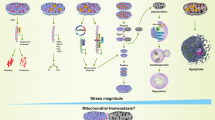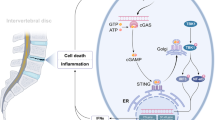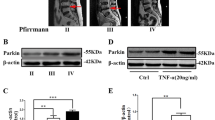Abstract
Intervertebral disc (IVD) degeneration is largely a process of destruction and failure of the extracellular matrix (ECM), and symptomatic IVD degeneration is thought to be one of the leading causes of morbidity or life quality deterioration in the elderly. To date, however, the mechanism of IVD degeneration is still not fully understood. Cellular loss from cell death in the process of IVD degeneration has long been confirmed and considered to contribute to ECM degradation, but the causes and the manners of IVD cell death remain unclear. Programmed cell death (PCD) is executed by an active cellular process and is extensively involved in many physiological and pathological processes, including embryonic development and human degenerative diseases. Thus, the relationship between PCD and IVD degeneration has become a new research focus of interest in recent years. By reviewing the available literature concentrated on PCD in IVD and discussing the methodology of detecting PCD in IVD cells, its inducing factors, the relationship of cell death to ECM degradation, and the potential therapy for IVD degeneration by modulation of PCD, we conclude that IVD cells undergo PCD via different signal transduction pathways in response to different stimuli, that PCD may play a role in the process of IVD degeneration, and that modulation of PCD might be a potential therapeutic strategy for IVD degeneration.
Similar content being viewed by others
References
Rudert M, Tillmann B (1993) Detection of lymph and blood vessels in the human intervertebral disc by histochemical and immunohistochemical methods. Ann Anat 175:237–42
Holm S, Maroudas A, Urban JP, Selstam G, Nachemson A (1981) Nutrition of the intervertebral disc: solute transport and metabolism. Connect Tissue Res 8:101–19
Waddell G (1996) Low back pain: a twentieth century health care enigma. Spine 21:2820–825
Waddell G (1991) Low back disability. A syndrome of Western civilization. Neurosurg Clin N Am 2:719–38
Ishii T, Tsuji H, Sano A, Katoh Y, Matsui H, Terahata N (1991) Histochemical and ultrastructural observations on brown degeneration of human intervertebral disc. J Orthop Res 9:78–0
Yasuma T, Koh S, Okamura T, Yamauchi Y (1990) Histological changes in aging lumbar intervertebral discs. Their role in protrusions and prolapses. J Bone Joint Surg Am 72:220–29
Thompson JP, Pearce RH, Schechter MT, Adams ME, Tsang IK, Bishop PB (1990) Preliminary evaluation of a scheme for grading the gross morphology of the human intervertebral disc. Spine 15:411–15
Trout JJ, Buckwalter JA, Moore KC, Landas SK (1982) Ultrastructure of the human intervertebral disc. I. Changes in notochordal cells with age. Tissue Cell 14:359–69
Urban MR, Fairbank JC, Bibby SR, Urban JP (2001) Intervertebral disc composition in neuromuscular scoliosis: changes in cell density and glycosaminoglycan concentration at the curve apex. Spine 26:610–17
Duance VC, Crean JK, Sims TJ et al (1998) Changes in collagen cross-linking in degenerative disc disease and scoliosis. Spine 23:2545–551
Sztrolovics R, Alini M, Roughley PJ, Mort JS (1997) Aggrecan degradation in human intervertebral disc and articular cartilage. Biochem J 326 (Pt 1):235–41
Antoniou J, Steffen T, Nelson F et al (1996) The human lumbar intervertebral disc: evidence for changes in the biosynthesis and denaturation of the extracellular matrix with growth, maturation, ageing, and degeneration. J Clin Invest 98:996–003
Antoniou J, Goudsouzian NM, Heathfield TF et al (1996) The human lumbar endplate. Evidence of changes in biosynthesis and denaturation of the extracellular matrix with growth, maturation, aging, and degeneration. Spine 21:1153–161
Hormel SE, Eyre DR (1991) Collagen in the ageing human intervertebral disc: an increase in covalently bound fluorophores and chromophores. Biochim Biophys Acta 1078:243–50
Kerr JF, Wyllie AH, Currie AR (1972) Apoptosis: a basic biological phenomenon with wide-ranging implications in tissue kinetics. Br J Cancer 26:239–57
Sperandio S, de Belle I, Bredesen DE (2000) An alternative, nonapoptotic form of programmed cell death. Proc Natl Acad Sci USA 97:14376–4381
Perez HE, Luna MJ, Rojas ML, Kouri JB (2005) Chondroptosis: an immunohistochemical study of apoptosis and Golgi complex in chondrocytes from human osteoarthritic cartilage. Apoptosis 10:1105–110
Roach HI, Aigner T, Kouri JB (2004) Chondroptosis: a variant of apoptotic cell death in chondrocytes? Apoptosis 9:265–77
Broker LE, Kruyt FA, Giaccone G (2005) Cell death independent of caspases: a review. Clin Cancer Res 11:3155–162
Anderson AJ, Su JH, Cotman CW (1996) DNA damage and apoptosis in Alzheimer’s disease: colocalization with c-Jun immunoreactivity, relationship to brain area, and effect of postmortem delay. J Neurosci 16:1710–719
Smale G, Nichols NR, Brady DR, Finch CE, Horton WE Jr (1995) Evidence for apoptotic cell death in Alzheimer’s disease. Exp Neurol 133:225–30
Su JH, Anderson AJ, Cummings BJ, Cotman CW (1994) Immunohistochemical evidence for apoptosis in Alzheimer’s disease. Neuroreport 5:2529–533
Charakidas A, Kalogeraki A, Tsilimbaris M, Koukoulomatis P, Brouzas D, Delides G (2005) Lens epithelial apoptosis and cell proliferation in human age-related cortical cataract. Eur J Ophthalmol 15:213–20
Lee EH, Wan XH, Song J et al (2002) Lens epithelial cell death and reduction of anti-apoptotic protein Bcl-2 in human anterior polar cataracts. Mol Vis 8:235–40
Li WC, Kuszak JR, Dunn K et al (1995) Lens epithelial cell apoptosis appears to be a common cellular basis for non-congenital cataract development in humans and animals. J Cell Biol 130:169–81
Kim HA, Lee YJ, Seong SC, Choe KW, Song YW (2000) Apoptotic chondrocyte death in human osteoarthritis. J Rheumatol 27:455–62
Heraud F, Heraud A, Harmand MF (2005) Apoptosis in normal and osteoarthritic human articular cartilage. Ann Rheum Dis 59:959–65
Hashimoto S, Ochs RL, Komiya S, Lotz M (1998) Linkage of chondrocyte apoptosis and cartilage degradation in human osteoarthritis. Arthritis Rheum 41:1632–638
Blanco FJ, Guitian R, Vazquez-Martul E, de Toro FJ, Galdo F (1998) Osteoarthritis chondrocytes die by apoptosis. A possible pathway for osteoarthritis pathology. Arthritis Rheum 41:284–89
Gruber HE, Hanley EN Jr (1998) Analysis of aging and degeneration of the human intervertebral disc. Comparison of surgical specimens with normal controls. Spine 23:751–57
Ahsan R, Tajima N, Chosa E, Sugamata M, Sumida M, Hamada M (2001) Biochemical and morphological changes in herniated human intervertebral disc. J Orthop Sci 6:510–18
Wang YJ, Shi Q, Sun P et al (2006) Insulin-like growth factor-1 treatment prevents anti-fas antibody-induced apoptosis in endplate chondrocytes. Spine 31:736–41
Gavrieli Y, Sherman Y, Ben-Sasson SA (1992) Identification of programmed cell death in situ via specific labeling of nuclear DNA fragmentation. J Cell Biol 119:493–01
Facchinetti A, Tessarollo L, Mazzocchi M, Kingston R, Collavo D, Biasi G (1991) An improved method for the detection of DNA fragmentation. J Immunol Methods 136:125–31
Gold R, Schmied M, Giegerich G et al (1994) Differentiation between cellular apoptosis and necrosis by the combined use of in situ tailing and nick translation techniques. Lab Invest 71:219–25
Mangili F, Cigala C, Santambrogio G (1999) Staining apoptosis in paraffin sections. Advantages and limits. Anal Quant Cytol Histol 21:273–76
Ariga K, Yonenobu K, Nakase T et al (2003) Mechanical stress-induced apoptosis of endplate chondrocytes in organ-cultured mouse intervertebral discs: an ex vivo study. Spine 28:1528–533
Ariga K, Miyamoto S, Nakase T et al (2001) The relationship between apoptosis of endplate chondrocytes and aging and degeneration of the intervertebral disc. Spine 26:2414–420
Chen B, Fellenberg J, Wang H, Carstens C, Richter W (2005) Occurrence and regional distribution of apoptosis in scoliotic discs. Spine 30:519–24
Court C, Colliou OK, Chin JR, Liebenberg E, Bradford DS, Lotz JC (2001) The effect of static in vivo bending on the murine intervertebral disc. Spine J 1:239–45
Ha KY, Koh IJ, Kirpalani PA et al (2006) The expression of hypoxia inducible factor-1alpha and apoptosis in herniated discs. Spine 31:1309–313
Heyde CE, Tschoeke SK, Hellmuth M, Hostmann A, Ertel W, Oberholzer A (2006) Trauma induces apoptosis in human thoracolumbar intervertebral discs. BMC Clin Pathol 6:5
Hutton WC, Ganey TM, Elmer WA et al (2000) Does long-term compressive loading on the intervertebral disc cause degeneration? Spine 25:2993–004
Kim KW, Kim YS, Ha KY et al (2005) An autocrine or paracrine Fas-mediated counterattack: a potential mechanism for apoptosis of notochordal cells in intact rat nucleus pulposus. Spine 30:1247–251
Kohyama K, Saura R, Doita M, Mizuno K (2000) Intervertebral disc cell apoptosis by nitric oxide: biological understanding of intervertebral disc degeneration. Kobe J Med Sci 46:283–95
Kroeber M, Unglaub F, Guehring T et al (2005) Effects of controlled dynamic disc distraction on degenerated intervertebral discs: an in vivo study on the rabbit lumbar spine model. Spine 30:181–87
Kroeber MW, Unglaub F, Wang H, et al. (2002) New in vivo animal model to create intervertebral disc degeneration and to investigate the effects of therapeutic strategies to stimulate disc regeneration. Spine 27:2684–690
Lotz JC, Chin JR (2000) Intervertebral disc cell death is dependent on the magnitude and duration of spinal loading. Spine 25:1477–483
Lotz JC, Colliou OK, Chin JR, Duncan NA, Liebenberg E (1998) Compression-induced degeneration of the intervertebral disc: an in vivo mouse model and finite-element study. Spine 23:2493–506
Park JB, Chang H, Kim KW (2001) Expression of Fas ligand and apoptosis of disc cells in herniated lumbar disc tissue. Spine 26:618–21
Park JB, Lee JK, Park SJ, Kim KW, Riew KD (2005) Mitochondrial involvement in fas-mediated apoptosis of human lumbar disc cells. J Bone Joint Surg Am 87:1338–342
Rannou F, Lee TS, Zhou RH et al (2004) Intervertebral disc degeneration: the role of the mitochondrial pathway in annulus fibrosus cell apoptosis induced by overload. Am J Pathol 164:915–24
Risbud MV, Fertala J, Vresilovic EJ, Albert TJ, Shapiro IM (2005) Nucleus pulposus cells upregulate PI3K/Akt and MEK/ERK signaling pathways under hypoxic conditions and resist apoptosis induced by serum withdrawal. Spine 30:882–89
Walsh AJ, Lotz JC (2004) Biological response of the intervertebral disc to dynamic loading. J Biomech 37:329–37
Gruber HE, Norton HJ, Hanley EN Jr (2000) Anti-apoptotic effects of IGF-1 and PDGF on human intervertebral disc cells in vitro. Spine 25:2153–157
Rutella S, Rumi C, Pierelli L et al (2000) Granulocyte colony-stimulating factor perturbs lymphocyte mitochondrial function and inhibits cell cycle progression. Exp Hematol 28:612–25
Park JB, Park IC, Park SJ, Jin HO, Lee JK, Riew KD (2006) Anti-apoptotic effects of caspase inhibitors on rat intervertebral disc cells. J Bone Joint Surg Am 88:771–79
Anderson DG, Izzo MW, Hall DJ et al. (2002) Comparative gene expression profiling of normal and degenerative discs: analysis of a rabbit annular laceration model. Spine 27:1291–296
Park JB, Kim KW, Han CW, Chang H (2001) Expression of Fas receptor on disc cells in herniated lumbar disc tissue. Spine 26:142–46
van Antwerp DJ, Martin SJ, Kafri T, Green DR, Verma IM (1996) Suppression of TNF-alpha-induced apoptosis by NF-kappaB. Science 274:787–89
Iatridis JC, Mente PL, Stokes IA, Aronsson DD, Alini M (1999) Compression-induced changes in intervertebral disc properties in a rat tail model. Spine 24:996–002
Kaigle A, Ekstrom L, Holm S, Rostedt M, Hansson T (1998) In vivo dynamic stiffness of the porcine lumbar spine exposed to cyclic loading: influence of load and degeneration. J Spinal Disord 11:65–0
Buschmann MD, Hunziker EB, Kim YJ, Grodzinsky AJ (1996) Altered aggrecan synthesis correlates with cell and nucleus structure in statically compressed cartilage. J Cell Sci 109 (Pt 2):499–08
Bibby SR, Fairbank JC, Urban MR, Urban JP (2002) Cell viability in scoliotic discs in relation to disc deformity and nutrient levels. Spine 27:2220–228
Houben GB, Drost MR, Huyghe JM, Janssen JD, Huson A (1997) Nonhomogeneous permeability of canine anulus fibrosus. Spine 22:7–6
Ohshima H, Tsuji H, Hirano N, Ishihara H, Katoh Y, Yamada H (1989) Water diffusion pathway, swelling pressure, and biomechanical properties of the intervertebral disc during compression load. Spine 14:1234–244
Terahata N, Ishihara H, Ohshima H, Hirano N, Tsuji H (1994) Effects of axial traction stress on solute transport and proteoglycan synthesis in the porcine intervertebral disc in vitro. Eur Spine J 3:325–30
Ganey T, Libera J, Moos V et al (2003) Disc chondrocyte transplantation in a canine model: a treatment for degenerated or damaged intervertebral disc. Spine 28:2609–620
Gan JC, Ducheyne P, Vresilovic EJ, Shapiro IM (2003) Intervertebral disc tissue engineering II: cultures of nucleus pulposus cells. Clin Orthop Relat Res 315–24
Krammer PH (1999) CD95 (APO-1/Fas)-mediated apoptosis: live and let die. Adv Immunol 71:163–10
Hengartner MO (2000) The biochemistry of apoptosis. Nature 407:770–76
Luo X, Budihardjo I, Zou H, Slaughter C, Wang X (1998) Bid, a Bcl2 interacting protein, mediates cytochrome c release from mitochondria in response to activation of cell surface death receptors. Cell 94:481–90
Hu Z, Ito T, Yuri K, Xie C, Ozawa H, Kawata M (1998) In vivo time course of morphological changes and DNA degradation during the degeneration of castration-induced apoptotic prostate cells. Cell Tissue Res 294:153–60
Harvey AR, Robertson D (1992) Time-course and extent of retinal ganglion cell death following ablation of the superior colliculus in neonatal rats. J Comp Neurol 325:83–4
Alvarez L, Ortiz A (1999) The study of apoptosis in spine pathology. Spine 24:500
Aigner T, Kim HA (2002) Apoptosis and cellular vitality: issues in osteoarthritic cartilage degeneration. Arthritis Rheum 46:1986–996
Hashimoto S, Ochs RL, Rosen F et al (1998) Chondrocyte-derived apoptotic bodies and calcification of articular cartilage. Proc Natl Acad Sci USA 95:3094–099
Hayes AJ, Benjamin M, Ralphs JR (2001) Extracellular matrix in development of the intervertebral disc. Matrix Biol 20:107–21
Buckwalter JA, Smith KC, Kazarien LE, Rosenberg LC, Ungar R (1989) Articular cartilage and intervertebral disc proteoglycans differ in structure: an electron microscopic study. J Orthop Res 7:146–51
Nerlich AG, Weiler C, Zipperer J, Narozny M, Boos N (2002) Immunolocalization of phagocytic cells in normal and degenerated intervertebral discs. Spine 27:2484–490
Uller L, Andersson M, Greiff L, Persson CG, Erjefalt JS (2004) Occurrence of apoptosis, secondary necrosis, and cytolysis in eosinophilic nasal polyps. Am J Respir Crit Care Med 170:742–47
Vermes I, Haanen C, Richel DJ, Schaafsma MR, Kalsbeek-Batenburg E, Reutelingsperger CP (1997) Apoptosis and secondary necrosis of lymphocytes in culture. Acta Haematol 98:8–3
Johnson EF, Mitchell R, Berryman H, Cardoso S, Ueal O, Patterson D (1986) Secretory cells in the nucleus pulposus of the adult human intervertebral disc. A preliminary report. Acta Anat (Basel) 125:161–64
Cao L, Lee V, Adams ME et al (1999) beta-Integrin-collagen interaction reduces chondrocyte apoptosis. Matrix Biol 18:343–55
Frisch SM, Francis H (1994) Disruption of epithelial cell-matrix interactions induces apoptosis. J Cell Biol 124:619–26
Rudolphi K, Gerwin N, Verzijl N, van der Kraan P, van den Berg W (2003) Pralnacasan, an inhibitor of interleukin-1beta converting enzyme, reduces joint damage in two murine models of osteoarthritis. Osteoarthritis Cartilage 11:738–46
Kim KW, Lim TH, Kim JG, Jeong ST, Masuda K, An HS (2003) The origin of chondrocytes in the nucleus pulposus and histologic findings associated with the transition of a notochordal nucleus pulposus to a fibrocartilaginous nucleus pulposus in intact rabbit intervertebral discs. Spine 28:982–90
Trout JJ, Buckwalter JA, Moore KC (1982) Ultrastructure of the human intervertebral disc: II. Cells of the nucleus pulposus. Anat Rec 204:307–14
Buckwalter JA (1995) Aging and degeneration of the human intervertebral disc. Spine 20:1307–314
Benneker LM, Heini PF, Alini M, Anderson SE, Ito K (2005) Vertebral endplate marrow contact channel occlusions and intervertebral disc degeneration. Spine 30:167–73
Rajasekaran S, Babu JN, Arun R, Armstrong BR, Shetty AP, Murugan S (2004) A study of diffusion in human lumbar discs: a serial magnetic resonance imaging study documenting the influence of the endplate on diffusion in normal and degenerate discs. Spine 29:2654–667
Nelson DA, Tan TT, Rabson AB, Anderson D, Degenhardt K, White E (2004) Hypoxia and defective apoptosis drive genomic instability and tumorigenesis. Genes Dev 18:2095–107
O’Reilly LA, Huang DC, Strasser A (1996) The cell death inhibitor Bcl-2 and its homologues influence control of cell cycle entry. Embo J 15:6979–990
Author information
Authors and Affiliations
Corresponding author
Rights and permissions
About this article
Cite this article
Zhao, CQ., Jiang, LS. & Dai, LY. Programmed cell death in intervertebral disc degeneration. Apoptosis 11, 2079–2088 (2006). https://doi.org/10.1007/s10495-006-0290-7
Published:
Issue Date:
DOI: https://doi.org/10.1007/s10495-006-0290-7




